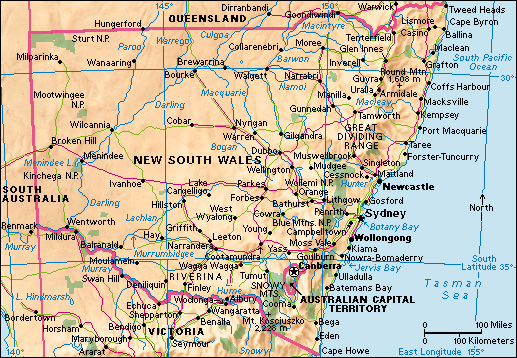Moree (pop. 7,070) is a rural town in New South Wales, Australia. It sits on a floodplain near the Gwydir and Mehi rivers. The town is part of the Moree Plains Shire government region. It has an agricultural economy, with farmers growing such crops as cotton, pecan nuts, and wheat. Many farmers also raise cattle and sheep. Moree residents are also employed in the manufacturing, tourism, and transportation industries. 
Among Moree’s major tourist attractions are its artesian baths and swimming pool. The site, now part of the Moree Artesian Aquatic Centre, opened in 1895. The baths draw water from an artesian well, which taps ground water which is under pressure. The water comes from a naturally heated underground reserve known as the Great Artesian Basin. The basin is one of the largest fresh ground water reservoirs in the world.
The Moree pool was the subject of important protests during the 1965 Freedom Rides, which were inspired by the United States freedom rider protests against racial discrimination. For Australia’s Freedom Rides, students and activists traveled through rural Australia protesting discrimination against Aboriginal people. At the time, a local law banned Aboriginal children from swimming in the Moree pool unless they were enrolled in a school swimming elective. Following public demonstrations by the freedom riders, the Moree council agreed to change the law.
The land on which Moree now sits was traditionally inhabited by the Kamilaroi people, one of the largest Aboriginal groups on the east coast of Australia. The first European person known to live in the area was George Clarke, a British convict (criminal) who was transported to Australia and forced into service. In the 1820’s, Clarke escaped and hid with the Kamilaroi people. After his recapture in 1831, Clarke told colonial authorities about the region. Clarke’s information was passed to the Australian explorer Thomas Livingstone Mitchell. Mitchell encountered the area during his 1831-1832 exploration of the region’s river systems.
Several pastoral (livestock farming) settlements, including Moree, were established in the area in the 1840’s. Moree officially became a town in 1862. The first railway line reached the town in 1897.
Moree has been impacted by floods throughout its history. Its worst recorded flood occurred in February 1955, when floodwaters submerged most of the town’s central business district. Other significant floods occurred in 1971, 2012, and 2022.
